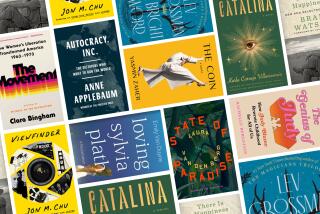Book Review : Reality, Illusion Blur in Memoir of a Madwoman
Memoirs of Many in One: by Alex Xenophon Demirjian Gray; edited by Patrick White (Viking: $15.95; 192 pp.)
Who is she? Is the purported “author” of this novel, Alex Xenophon Demirjian Gray, as the title suggests, not one woman but many? Has she, as she states in her memoirs, led many lives including that of a blue-eyed Greek nun groaning under the weighty advances of her abbot? Is it memory or invention when she appears as an aging actress who plays a confident Cleopatra in the Australian outback? Is she mad?
She is at once invincible and vulnerable, and it is this old woman’s remarkable voice that takes command of the novel and propels us through her insanity, her imagination, her wit and biting insight into the very nature of fiction writing itself. Throughout this novel, fiction piles upon fiction, as the “real” author, Nobel Prize winner Patrick White, enters this novel as his own character--Patrick, friend of Alex Gray, whose daughter Hilda has asked him to edit her mother’s memoirs.
In the same way that the fiction within the fiction blurs the lines between reality and illusion, so too, the lines blur between Alex’s imagined past and her plausible present, as corroborated by her stalwart daughter Hilda (who rescues her mother from her frequent escapes into the park) and her friend Patrick (who occasionally interrupts this tale with Editor’s Notes).
The novel examines the relationship between the writer and his imaginative world at every twist and turn in its confusing story line. White pages haunt the imagery, as does the act of writing itself--for the escapades described here are memoirs, the memoirs of what is finally, clearly a mad woman, and an implicit debate--sanity versus insanity, performances versus the real--hovers over every encounter.
In the end, after a series of adventures and incarnations including one as the wife of Hilary Gray, where she dances across the floor of a Washington party flinging her jewels from a basket, and another as the monologist Dorothy Formosa, Alex is incarcerated in a hospital, arms wrapped behind her back. Here the white paper (“foolscap”) on the bedside table looms especially large. When her hands are finally loosed, all she can do is run a savage red line in ink across the page, like a knife into flesh.
Although Patrick and Hilda make appearances, the fascination in this novel is within the folds and furrows of Alex’s mind as they fall around the reader like a medieval tapestry that will yield a story if only we learn how to see. There is not always sufficient light. We often see only pieces--the deer, the boar, the unclear sex of the hunter. Eventually, however, sheer madness to the outside world becomes, for the reader, a kind of inevitable logic.
Some Funny Moments
There are some funny moments, as when Alex, having shocked and ruined a party by galloping through it, turns to the screaming hostess and writes: “There was nothing to do but regain unconsciousness.” But the humor will for the most part elude American readers. Like the British love of the pratfall, which frequently leaves Americans dumbfounded, the frequency of wind here, and its less than hilarious passage through the digestive tract, won’t clear customs, as it were. And some of White’s ideas about age are painfully wrong-headed. One does not cease to love, or be loved simply because one is old, after all.
But the startling achievement of this often bitter and savage book is not only the remarkable beauty of its prose but the geniality, even the familiarity of the erotically madcap Alex Gray. We slip into this madness as into a second skin.
More to Read
Sign up for our Book Club newsletter
Get the latest news, events and more from the Los Angeles Times Book Club, and help us get L.A. reading and talking.
You may occasionally receive promotional content from the Los Angeles Times.






